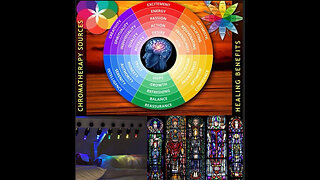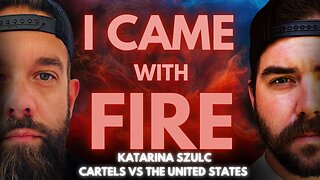Premium Only Content

The Alchemy of Thought: Master Your Mind, Transform Your Reality
### **Introduction:**
The ability to think deeply and effectively is the cornerstone of human experience, shaping our reality and influencing every aspect of our lives. Thought is not merely a byproduct of the mind but an alchemical process that, when mastered, can lead to profound personal transformation and the creation of a reality aligned with one’s highest potential. This exploration delves into the art and science of thinking, offering advanced insights and techniques to refine and elevate your mental faculties.
### **Core Foundations:**
1. **The Essence of Thought vs. Mental Activity:**
- **Distinction and Purpose:** True thinking is a deliberate, conscious process distinct from the automatic, often chaotic mental activity that dominates much of our cognitive landscape. Engaging in mindfulness practices allows us to distinguish between mere mental chatter and purposeful thinking. By becoming aware of this distinction, we can cultivate a habit of active thinking—focused, intentional, and directed toward meaningful outcomes.
- **Practical Application:** Implement metacognitive strategies such as reflective journaling and thought audits to consistently evaluate the quality and direction of your thinking. This self-awareness serves as the foundation for cognitive mastery.
2. **Harmonizing the Conscious and Subconscious Mind:**
- **Integration Techniques:** The conscious mind is the seat of reasoning and decision-making, while the subconscious mind governs habits, beliefs, and emotional responses. To align these two aspects, techniques such as creative visualization, affirmations, and autosuggestion are employed. These methods reprogram the subconscious, aligning it with the conscious goals, thereby creating a unified mental state that propels you toward your objectives.
- **Advanced Practice:** Develop a daily routine that includes visualization sessions, where you vividly imagine your goals as already achieved, embedding these images deeply into your subconscious mind to create a powerful internal motivation system.
3. **Cultivating Intellectual Faculties:**
- **Refinement and Enhancement:** The mind’s intellectual faculties—reason, imagination, memory, perception, will, and intuition—are the tools of thought. Each of these can be sharpened through specific exercises. For instance, reason can be enhanced through logical puzzles, imagination through creative visualization, and willpower through disciplined practice in daily tasks.
- **Advanced Techniques:** Engage in mental exercises that challenge each faculty, such as abstract reasoning puzzles for logic, memory palaces for recall, and mindfulness meditation for enhancing perception and intuition. These practices, when integrated into daily life, lead to a well-rounded and highly functional intellect.
### **Strategic Applications:**
1. **Mastering Critical Thinking:**
- **Frameworks and Application:** Critical thinking is the ability to analyze, synthesize, and evaluate information objectively. By mastering frameworks like the Socratic method, SWOT analysis, and systems thinking, one can apply these techniques to real-world problems with precision. Regular engagement in thought experiments and critical discussions with peers also sharpens this faculty, ensuring that it becomes a natural part of your cognitive toolkit.
- **Advanced Application:** Use critical thinking frameworks to deconstruct complex issues, such as ethical dilemmas or strategic business decisions. This methodical approach ensures that your conclusions are well-founded and comprehensive.
2. **Building Mental Resilience:**
- **Psychological Techniques:** Mental resilience is the ability to remain focused and effective under pressure. Techniques from sports psychology, such as visualization, stress inoculation, and cognitive restructuring, are powerful tools to build this resilience. By preparing mentally for high-stakes situations, you can maintain clarity and make sound decisions even in the most challenging circumstances.
- **Advanced Practice:** Incorporate resilience training into your daily routine by practicing stress management techniques like controlled breathing, visualization of successful outcomes, and cognitive rehearsal of challenging scenarios.
### **Advanced Insights and Techniques:**
1. **The Interplay of Emotion and Thought:**
- **Emotional Intelligence Integration:** Thoughts and emotions are deeply interconnected, with each influencing the other. Developing emotional intelligence—through self-awareness, empathy, and emotional regulation—enhances cognitive processes, leading to more balanced and effective decision-making. This integration creates a holistic approach to thinking where both rational and emotional insights are valued.
- **Advanced Application:** Practice emotional regulation techniques, such as mindfulness meditation and emotional labeling, to maintain a calm and focused mind. This emotional equilibrium allows for clearer and more strategic thinking.
2. **Unleashing Creative Thought:**
- **Breaking Conventional Patterns:** Creativity involves breaking free from conventional thought patterns and exploring novel ideas. Engaging in lateral thinking exercises, mind mapping, and creative brainstorming sessions fosters innovation and expands cognitive flexibility. This creative expansion is essential not only in the arts but in problem-solving across all disciplines.
- **Advanced Techniques:** Implement techniques like random word associations and reverse brainstorming to challenge your usual thought patterns, leading to breakthroughs in innovation and creative problem-solving.
### **Common Pitfalls and Strategic Corrections:**
1. **Misconceptions About Thinking:**
- **Awareness and Correction:** A common misconception is that all mental activity equates to thinking. This leads to confusion between passive mental drift and active cognitive engagement. Regular self-reflection and metacognitive practices help to identify and correct these misconceptions, ensuring that your mental energy is directed toward productive thinking.
- **Strategic Correction:** Schedule regular thought reviews, where you assess the effectiveness of your thinking process. Are your thoughts aligned with your goals? Are they constructive or merely reactive? This practice ensures that your thinking remains focused and effective.
2. **Neutralizing Negative Influences:**
- **Cognitive Reframing:** The subconscious mind is highly susceptible to negative influences, which can derail positive thinking and goal achievement. By practicing selective attention and cognitive reframing—where negative thoughts are consciously replaced with positive alternatives—you can create a mental environment conducive to growth and success.
- **Advanced Practice:** Implement a daily cognitive detox, where you consciously filter out negative inputs from your environment and replace them with positive, affirming content. This practice strengthens the positive conditioning of your subconscious mind.
### **Interdisciplinary Connections:**
1. **Applying Cognitive Psychology:**
- **Bias Recognition and Overcoming:** Cognitive psychology provides tools for recognizing and overcoming cognitive biases that distort thinking. Understanding biases such as confirmation bias, anchoring, and availability heuristic allows for a clearer and more objective thought process. By applying these principles, you can enhance your critical thinking and decision-making abilities.
- **Advanced Application:** Regularly challenge your assumptions and seek out information that contradicts your current beliefs. This practice helps in recognizing and mitigating cognitive biases, leading to more balanced and informed thinking.
2. **Harnessing Neuroscience Insights:**
- **Neuroplasticity and Thought:** Neuroscience reveals that the brain is malleable and capable of forming new neural connections throughout life—a concept known as neuroplasticity. By engaging in consistent mental exercises, you can rewire your brain to enhance cognitive functions, memory, and creative abilities. This insight underscores the importance of lifelong learning and mental discipline.
- **Advanced Techniques:** Engage in neuroplasticity-enhancing activities, such as learning new skills, practicing meditation, and regularly challenging your brain with puzzles and problem-solving tasks. These activities stimulate neural growth and enhance cognitive flexibility.
### **Mindset and Cognitive Frameworks:**
1. **Embracing a Growth Mindset:**
- **Openness to Challenges:** A growth mindset is the belief that abilities and intelligence can be developed through effort and perseverance. This mindset encourages embracing challenges, viewing failures as opportunities for growth, and persisting in the face of setbacks. Cultivating a growth mindset is crucial for continuous improvement in thinking and problem-solving.
- **Advanced Practice:** Regularly reflect on challenges and setbacks, identifying the lessons learned and applying them to future endeavors. This proactive approach to learning and growth fosters resilience and continuous cognitive development.
2. **Systems Thinking for Complex Problem-Solving:**
- **Holistic Approach:** Systems thinking involves understanding the interconnectedness of various components within a larger system. This approach is essential for tackling complex problems, as it allows for a comprehensive view of how different factors interact and influence each other. By adopting systems thinking, you can develop more effective strategies and solutions that address the root causes of issues rather than just the symptoms.
- **Advanced Techniques:** Apply systems thinking to real-world problems by mapping out the components of a system and their relationships. Use this map to identify leverage points—areas where a small change can have a significant impact—thereby developing more effective and sustainable solutions.
### **Ongoing Development and Mastery:**
1. **Commitment to Continuous Learning:**
- **Lifelong Growth:** Continuous learning is the key to mastery in any field. By consistently seeking out new knowledge, experiences, and challenges, you can keep your mind sharp and adaptable. Engage in reflective practices, such as journaling and peer discussions, to track your progress and refine your thinking abilities.
- **Advanced Practice:** Develop a personalized learning plan that includes goals, resources, and timelines for acquiring new knowledge and skills. Regularly assess your progress and adjust your plan as needed to ensure continuous growth.
2. **Adaptive and Flexible Thinking:**
- **Responsive Thinking:** In a rapidly changing world, the ability to adapt your thinking strategies to new situations and challenges is crucial. By remaining open to feedback and continuously refining your thought processes, you can ensure that your thinking remains effective and relevant in any context.
- **Advanced Techniques:** Practice adaptive thinking by regularly exposing yourself to new ideas, perspectives, and challenges. Engage in activities that require quick thinking and decision-making, such as strategic games or timed problem-solving exercises, to enhance your cognitive flexibility.
### **Conclusion: The Mastery of Thought as a Gateway to a Transformed Reality**
Mastering the art of thinking is not just about solving problems or making decisions; it is about transforming the way you experience and interact with reality. By refining your cognitive faculties, embracing a growth mindset, and cultivating a deeper awareness of both your conscious and subconscious processes, you open the door to a higher level of existence—one where you actively shape your destiny rather than passively reacting to life’s circumstances.
The ability to think deeply and effectively empowers you to break free from the constraints of habitual thought patterns, enabling you to explore new possibilities and achieve your highest potential. It allows you to perceive connections and patterns that others might overlook, to solve complex problems with creativity and insight, and to navigate the challenges of life with resilience and clarity.
### **Transformative Practices for Mastering Thought:**
1. **Holistic Cognitive Discipline:**
- **Integrated Practice:** To truly master thought, adopt a holistic approach that integrates intellectual, emotional, and spiritual development. Engage in practices such as meditation, journaling, and reflective reading, which promote deep introspection and self-awareness. Combine these with intellectual exercises that challenge and expand your cognitive abilities.
- **Advanced Application:** Create a daily routine that includes time for intellectual growth (reading, learning), emotional balance (meditation, emotional journaling), and spiritual connection (prayer, contemplation). This balanced approach ensures that your thinking is not only sharp but also grounded in emotional and spiritual wisdom.
2. **Engagement with Advanced Theories and Concepts:**
- **Intellectual Expansion:** Dive into advanced theories in fields such as quantum mechanics, neuroscience, philosophy, and metaphysics. These areas of study can significantly expand your cognitive horizons and challenge you to think in new, multidimensional ways.
- **Advanced Practice:** Explore complex, interdisciplinary topics that require you to synthesize knowledge from various fields. Engage in discussions with others who share an interest in these areas, and apply what you learn to your personal and professional life.
3. **Cultivating Synchronicity and Intuition:**
- **Harmonizing Rationality with Intuition:** Synchronicity and intuition are essential components of a well-rounded thinking process. While rational analysis is crucial, recognizing and interpreting synchronicities and intuitive insights can provide you with guidance that transcends linear logic.
- **Advanced Techniques:** Practice recognizing patterns and synchronicities in your daily life. Keep a journal to document these occurrences and reflect on their significance. Pair this with exercises that strengthen your intuition, such as mindful observation or creative problem-solving tasks that rely on instinctual responses.
4. **Ethical and Purpose-Driven Thinking:**
- **Alignment with Higher Values:** The ultimate goal of mastering thought is not just personal gain, but the alignment of your cognitive abilities with higher ethical and spiritual values. This ensures that the power of your thinking is used for purposes that benefit not only yourself but also the broader community and the world.
- **Advanced Practice:** Regularly evaluate your goals and decisions through the lens of ethical and spiritual principles. Consider the long-term impact of your actions on others and the environment, and strive to make choices that reflect your highest values.
### **Final Thought: The Journey of Thought Mastery**
The journey to mastering thought is a lifelong process, one that requires dedication, curiosity, and a willingness to challenge your own assumptions. As you continue to refine your thinking skills, you will find that your ability to shape your reality becomes increasingly powerful. You will begin to see the world not just as it is, but as it can be—molded by the creative and transformative power of your mind.
In this journey, you are not merely a passive observer of reality but an active participant in the ongoing creation of the universe. Your thoughts, when mastered, become tools for manifesting your deepest desires and highest aspirations. By committing to this path, you step into your full potential as a conscious creator, capable of influencing not only your own life but also the collective reality of humanity.
### **Call to Action: Embrace the Power of Thought**
As you move forward, take the time to cultivate and refine your thinking processes. Challenge yourself to think more deeply, more creatively, and more holistically. Embrace the art of thinking as a lifelong practice, one that will continue to evolve and expand as you grow. By doing so, you will not only transform your own life but also contribute to the creation of a more conscious, thoughtful, and harmonious world.
Remember, the mastery of thought is the gateway to a transformed reality. Embrace this journey with dedication and purpose, and watch as your world unfolds in alignment with your highest visions and aspirations.
### The Reality Shaper: Mastering Thought to Transform Your Reality
**Objective:** To develop profound self-awareness and mastery over your thoughts, enabling you to shape your reality with intention and clarity. This exercise is designed to deepen your understanding of how beliefs, emotions, and conscious awareness interact to create the world you experience, and to empower you with the tools to reshape that world according to your highest goals and values.
---
#### **Step 1: Identifying Core Beliefs**
1. **Deep Reflection:** Set aside 20 minutes in a quiet space where you won't be disturbed. Begin by calming your mind through deep breathing or meditation. Once centered, write down your core beliefs about yourself, life, and your place in the universe. These beliefs are the foundational lenses through which you perceive reality.
2. **Insightful Analysis:** Review your beliefs and categorize them into those that empower and those that limit you. For each limiting belief, ask yourself:
- **Origin:** Where did this belief come from? Was it instilled by your family, society, or past experiences?
- **Validity:** Is this belief universally true, or is it based on subjective interpretation?
- **Impact:** How has this belief shaped your life so far? What has it cost you in terms of opportunities, relationships, and personal growth?
3. **Focused Selection:** Choose the limiting belief that has had the most significant impact on your life. This will be the belief you will transform throughout this exercise.
---
#### **Step 2: Deconstructing and Reconstructing Beliefs**
1. **Deep Deconstruction:** Analyze the chosen limiting belief thoroughly:
- **Evidence:** What evidence have you used to support this belief? Is this evidence truly objective?
- **Influence:** How has this belief dictated your choices, behaviors, and interactions? Reflect on specific instances where this belief has held you back.
- **Root Cause:** Consider the emotions and experiences that gave rise to this belief. Understanding its root can help in dislodging it.
2. **Creative Reconstruction:** Now, craft a new, empowering belief to replace the limiting one. This new belief should align with your highest self, supporting your aspirations and reflecting your true potential.
- **Example:** Transform "I am not capable of achieving great things" into "I am constantly evolving and my potential is limitless."
- **Daily Affirmation:** Write a powerful affirmation based on this new belief. Repeat this affirmation at least three times daily—upon waking, at midday, and before sleep—to reinforce its truth in your subconscious.
---
#### **Step 3: Advanced Visualization and Emotional Resonance**
1. **Visualization Practice:** Spend 10-15 minutes each day in a meditative state, visualizing yourself fully embodying your new belief. Engage all your senses to make the experience as vivid and real as possible. Picture specific scenarios where this belief guides your actions and decisions.
- **Advanced Example:** If your new belief is "I attract abundance in all forms," visualize yourself receiving unexpected gifts, financial opportunities, or support from others. Feel the emotions of gratitude, joy, and fulfillment as these manifestations unfold.
2. **Emotional Resonance:** While visualizing, deeply connect with the emotions that would accompany the realization of this belief. Emotions are potent catalysts for manifesting your thoughts into reality. The stronger and more consistent the emotional connection, the quicker the belief will take root in your subconscious.
- **Amplification Technique:** To amplify this process, play music that evokes the desired emotion, or use scent (like essential oils) to anchor the emotion to a particular sensory experience.
---
#### **Step 4: Thought Monitoring and Realignment**
1. **Continuous Monitoring:** Throughout your day, maintain a heightened awareness of your thoughts, especially in situations that challenge your new belief. Each time an old, limiting thought arises, recognize it without judgment. Awareness alone begins the process of transformation.
2. **Active Realignment:** Immediately replace the limiting thought with your new belief and its corresponding affirmation. Reinforce this shift by recalling the vivid imagery and emotions from your visualization practice. Over time, this conscious realignment will rewire your thought patterns, making the new belief your default mode of thinking.
3. **Tracking Progress:** Keep a journal to record instances where you successfully realigned your thoughts. This not only reinforces the new belief but also provides evidence of your growth and transformation over time.
---
#### **Step 5: Synthesis and Integration**
1. **Weekly Reflection:** At the end of each week, spend time reflecting on how your thoughts, emotions, and behaviors have shifted. Use journaling to capture these reflections. Notice any changes in your external reality—have opportunities appeared, have relationships improved, or has your sense of well-being increased?
2. **Deep Integration:** Continue this practice for 30 to 90 days, allowing the new belief to deeply integrate into your subconscious mind. As this belief takes root, you’ll notice a shift in your reality—opportunities, relationships, and experiences will begin to align with this new truth.
---
### **Advanced Techniques: Expanding the Practice Beyond the Individual**
**Collective Reality Shaping:** Once you’ve mastered these techniques personally, consider how they can be applied to collective realities. Engage with others in your community to deconstruct and reconstruct shared beliefs that shape societal norms. Use group meditations, collective visualizations, and shared affirmations to influence positive change on a larger scale.
- **Example:** Organize a community event where participants collectively visualize and affirm a peaceful, sustainable future. Encourage the group to focus on generating the collective emotions of love, unity, and abundance, thereby amplifying the impact of the exercise.
### **Conclusion: The Power of Thought in Crafting Reality**
This thought exercise is a profound practice for mastering the power of your mind. By transforming your core beliefs, engaging deeply with your emotions, and practicing conscious thought realignment, you step into the role of a deliberate creator of your reality. This exercise not only enhances personal growth but also has the potential to impact the collective consciousness, contributing to the creation of a world that reflects our highest aspirations.
-
 1:04
1:04
FragmentsOfTruth
1 day agoChromotherapy Transcended: A Multidimensional Tapestry of Light, Consciousness, and Healing
951 -
 LIVE
LIVE
SpartakusLIVE
4 hours ago#1 King of Content kicks off YOUR week with Monday MOTIVATION
725 watching -
 LIVE
LIVE
Akademiks
3 hours agoKendrick Lamar Sweeps Grammys. Drake announces new album on Feb 14. Rocky Trial Might get Dismissed?
3,505 watching -
 LIVE
LIVE
BrancoFXDC
57 minutes agoWarzone Rebirth Rounds
249 watching -
 1:44:14
1:44:14
Glenn Greenwald
7 hours agoRubio's Shift: What is Trump's Foreign Policy? Trump/Musk Attack CIA Fronts USAID & NED: With Mike Benz | SYSTEM UPDATE #401
55.6K48 -
 1:05:47
1:05:47
Donald Trump Jr.
9 hours agoMexico Sends Troops to Border, Plus USAid Scam Exposed, Live with Brooke Goldstein & Rep Brian Mast | TRIGGERED Ep.213
200K145 -
 9:26
9:26
Rethinking the Dollar
4 hours agoUnbelievable Government Waste: 5 Outrageous Biden-Era Spending Sprees
4.04K4 -
 LIVE
LIVE
Flyover Conservatives
22 hours agoDR. KIRK ELLIOTT | Deep Dive: Tariffs, Tech, and Total Economic Warfare – Who Wins and Who Loses? | In Studio - FOC Show
1,176 watching -
 LIVE
LIVE
Danny Polishchuk
6 hours agoTariffs and Trade Wars + Nick Rochefort | Low Value Mail #136
389 watching -
 LIVE
LIVE
I_Came_With_Fire_Podcast
8 hours agoCartels vs The United States, Fentanyls 2 Front WAR, and FTOs
187 watching